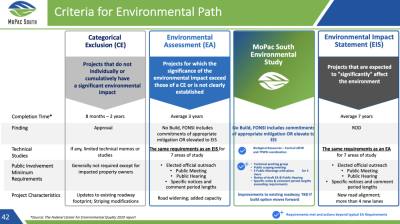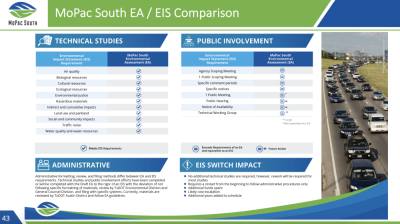Discussion at the March 29 board meeting questioned whether the organization should continue with the current environmental study being completed, called an Environmental Assessment, or opt for an Environmental Impact Study. The current assessment has been in the works since 2013 and would have to be completely restarted if the agency decided to make the switch, said Charlotte Gilpin, K Friese + Associates engineer and Mobility Authority consultant.
Different types of studies
With project limits spanning from Cesar Chavez Street in Central Austin to Slaughter Lane in Southwest Austin, several different options have been put forward in documents from the Mobility Authority to create more reliable travel times and improve road operations. Each option includes one to two express lanes in each direction. For more information on the current build alternatives, visit the Mobility Authority’s MoPac South page.
There are three types of studies done to comply with the National Environmental Policy Act, depending on the project:
- Environmental Impact Statement: for projects expected to have a large impact on the environment such as the addition a new road, acquiring right of way, adding several new lanes, or displacing homes and businesses
- Typically take seven years
- Require public meetings
- Require seven areas of study for project
- Categorical exclusions: projects that do not have significant environmental impact such as road restriping, adding guard rails, repaving
- Typically take eight months to seven years
- Limited amount of technical studies
- Environmental Assessments: Projects for which the environmental impact is not clearly established that do not fit into the above categories
- Takes three years on average
- Require public meetings
- Require seven areas of study for project
In the event the Environmental Assessment is switched to an Environmental Impact Statement, most studies already completed will have to be reworked, and the process will have to be restarted to adhere to proper administrative procedures, according to the Mobility Authority. The switch would cost the organization more money, and will likely cost more this time around. The change will also likely add additional years to the current project delivery schedule, according to the Mobility Authority.
In general, Environmental Impact Studies are more detailed and have more challenging requirements than Environmental Assessments, according to the Environmental Protection Agency.
This reputation for being more rigorous and comprehensive is why the board is considering the transition to an Environmental Impact Study instead, Board Member Armbrust said. The Travis County Commissioners Court also favors Environmental Impact Statements over Environmental Assessments, Armbrust said.
“I think we've wasted the last five years. We got off on the wrong foot on this in the beginning, and I just think we've spun our wheels," Armbrust said. "I'm strongly in favor of fixing MoPac South to the extent we can, but I don't know what that means. I think we just need to get this right, and I think an [Environmental Impact Statement] really is the way to do it.”
However, Gilpin and Chair Bobby Jenkins both stated the current Environmental Assessment being completed by the Mobility Authority goes far beyond the typical expectations of a normal Environmental Assessment.
“It is an incorrect statement to say that an [Environmental Impact Statement] will consider cumulative impacts when an [Environmental Assessment] does not,” Gilpin said. “For this particular project, there is no difference between an [Environmental Assessment] and an [Environmental Impact Statement] in terms of the technical work that our team is producing. The difference between the two really is the administrative and public engagement side.”
Gilpin and Jenkins both said that the technical studies the Mobility Authority has completed under the current Environmental Assessment regarding impacts to water, air, noise and other factors are identical to those that would be completed if they decided to restart and pursue an Environmental Impact Study instead. The main difference between the two studies at this stage are in the types of paperwork that would have been filed for the project, versus the quality of assessments completed, Gilpin said.
In Janurary 2022, the Travis County Commissioners Court raised questions concerning the legitimacy of the MoPac South expansion studies given the data used for studies was from 2015, the latest available at the time based off the Capital Area Metropolitan Planning Organization's projections for 2035. However, since then, the studies in the Environmental Assessment have been updated to CAMPO's more recent 2045 projections, Gilpin said.
Members of the Mobility Authority board expressed interest in setting up meetings with the Travis and Williamson County Commissioners to go over the information about differences between an Environmental Assessment and Environmental Impact Study. A timeline was not established during the March 28 meeting on when those work sessions would occur.
Future of the project
The Mobility Authority began discussions about the expansion of MoPac South in 2012, with the first open house for residents to learn more about the need for the project and potential build options in 2013. Five open houses for residents have been held since, with the most recent held virtually from November 2022 to January.
The Mobility Authority staff will recommend a preferred option to move forward with at the next open house, Gilpin said. There is no date currently set for the next open house, according to Mobility Authority documents.
Once the final environmental assessment is drafted, it is submitted to the Texas Department of Transportation, which either concludes the project will not have a significant impact to the surrounding area, or instructs that no construction should take place.
Even if TxDOT finds there is no significant impact of the project, the project is not automatically constructed, Gilpin said. A finding of no significant impact just means the project has the ability to be constructed in the event an agency agrees to fund and build the project. If an agency agrees to fund and construct the project, the construction is in accordance with the approved plans finding no significant impact, Gilpin said.







